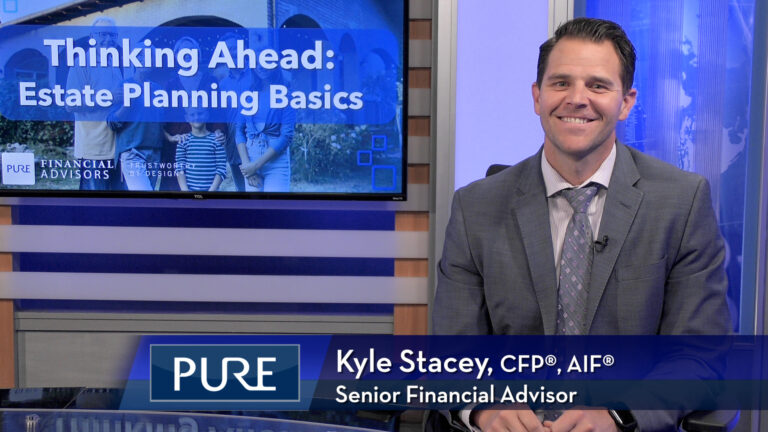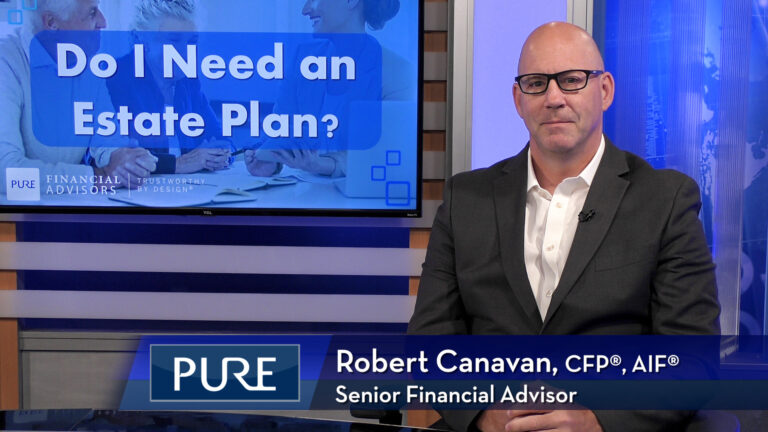For some, making a budget can feel intimidating, but you can do it! Pure’s Senior Financial Planner, Robert McCullock, CFP®, AIF® guides you through steps on how to create a budget, and if you stick to it monthly, you’ll be on plan to where you want to be.
FREE GUIDE | Financial New Year’s Resolutions: Tips for Getting Your Finances in Order
Transcript
How to Create a Budget
Now before creating a budget, I’m going to give you a little bit of homework. You’re going to need two things. First, you want to identify your average net income, what are you taking home what do you have to work with, at the beginning of the month. Step two, I want you to review your previous spending habits you can look over the last month, but it’s typically better to look back over the last year, as things vary from month to month.
Now, once you have these two pieces you can start creating your budget. Step one, the most important is to pay yourself! Paying yourself first is key because the whole point of the budget is the goals that you are trying to hit by having a budget. That is increasing your wealth so that is saving to your retirement accounts, education savings, it could be in a situation where you are critically trying to pay off debt and that’s fine too, just #1 pay yourself first.
Number two, after paying yourself first is going to be the more boring part of life that’s your fixed expenses, usually 50% of your take home pay. This is your mortgage, this is your rent, this is the utilities, this is your car payment, your gas, your groceries, whatever it is the basic needs that we all need to get by.
After we have our fixed expenses then we get to go and have a little bit more fun in life and that’s the variable expenses. This is going out to the restaurants, this is doing some shopping, your entertainment, your travel, your Starbucks, your wine of the month club, whatever that is for you, that’s going to be 25% of your take home.
So, lastly is the unexpected buffer, this is 5%. This is the key miss most people have in their budgeting, is not leaving room in the unexpected buffer. This is your emergency fund you want at least 5% every month to go to an emergency fund because life happens. Something will come up you’ll have a roof leak, you’ll have a car breakdown, or there’s going to be some sort of family emergency, and when that happens, it always happens at the worst part of life. We’ve already expended our fund money for the month. We still have to make our mortgage payments, so the only place left to go is back into that savings account or digging further into that credit card which we do not want to be doing.
Once you have that all together, make sure you review this monthly and adjust as needed with life. Things will change, expenses will change, jobs change, work change. If you stick to this monthly, adjust it with your life by the end of the year, you’ll be on plan to where you wanted to be.
Subscribe to our YouTube channel.
IMPORTANT DISCLOSURES:
• Investment Advisory and Financial Planning Services are offered through Pure Financial Advisors, LLC, a Registered Investment Advisor.
• Pure Financial Advisors LLC does not offer tax or legal advice. Consult with your tax advisor or attorney regarding specific situations.
• Opinions expressed are subject to change without notice and are not intended as investment advice or to predict future performance.
• Investing involves risk including the potential loss of principal. No investment strategy can guarantee a profit or protect against loss in periods of declining values.
• All information is believed to be from reliable sources; however, we make no representation as to its completeness or accuracy.
• Intended for educational purposes only and are not intended as individualized advice or a guarantee that you will achieve a desired result. Before implementing any strategies discussed you should consult your tax and financial advisors.
CFP® – The CERTIFIED FINANCIAL PLANNER™ certification is by the Certified Financial Planner Board of Standards, Inc. To attain the right to use the CFP® designation, an individual must satisfactorily fulfill education, experience and ethics requirements as well as pass a comprehensive exam. Thirty hours of continuing education is required every two years to maintain the designation.
AIF® – Accredited Investment Fiduciary designation is administered by the Center for Fiduciary Studies fi360. To receive the AIF Designation, an individual must meet prerequisite criteria, complete a training program, and pass a comprehensive examination. Six hours of continuing education is required annually to maintain the designation.














